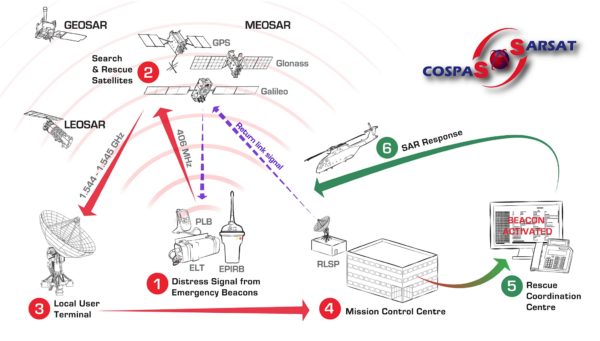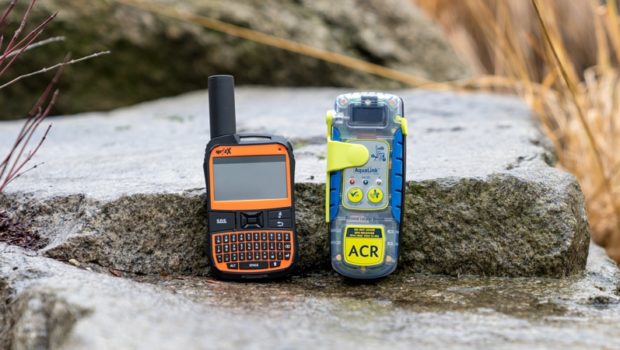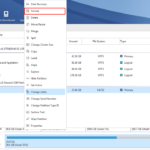How do Personal Locator Beacons work?
A PLB – when activated – connects to specialised search and rescue satellites, which in turn pass that message on to emergency authorities in the country where the beacon is activated.
The best PLBs have the ability for authorities to see where the signal is coming from and provide rescuers with a precise location using GPS in combination with the satellite signal.
Which satellites do these beacons use?
PLBs rely on the Cospas-Sarsat satellite network – an international group of satellites that is dedicated to search and rescue purposes. These satellites also conduct monitoring of aircraft distress signals. PLBs sends their signals to these satellites on the 406 Mhz frequency reserved for this purpose.

How do you use a PLB?
The first thing to do with a PLB is to register it with the search and rescue authorities in your country so that if it is activated, they know who they are looking for and may be able to see where you intended going and which relatives they can contact. Here in Australia, you have the ability to update your details prior to a trip to record where you are going and when.
The beacon we use – a KTI – operates like the majority of models on the market. It comes in a small case and is about the size of a small compact camera.
Before every trip, we test the beacon according to the instructions by unclipping the antenna, raising it and then pressing the test button. You can see from the combination of flashing lights that the beacon is working.
The KTI has a battery life of 10 years and can transmit for 24 hours once activated. It is both waterproof and self buoyant.
We bring it with us on all remote trips and keep it close to our body so we have it to hand if – for example – we are tipped out of our Hobie kayak or injure ourselves.
Just like the fish finder we use on the kayak, the PLB is a vital electronic aid to a good day on the water and gives a great deal of peace of mind while we are doing what can be a dangerous activity.
In the part of Australia where we live (Melbourne), the weather is notoriously variable and the wind can swing 180 degrees and gather strength in moments. One minute you are fishing in a millpond, and the next minute you are dealing with significant swell!
How to activate a PLB
If you are injured or lost and need to activate it, you unclip and raise the antenna, slide off the protective cover and push the red button until the green lights on the unit start flashing.
This immediately sends a signal to the satellite network with our position (via GPS). The satellite network can also triangulate the position of the beacon.
The beacon will continue to send this information in short bursts to conserve the battery life. Our model will transmit for at least 24 hours.
What happens next?
Rescue authorities will assess the location of the beacon at the time of activation before deciding on the appropriate action. If they can see the signal is coming from your home address, or in an urban environment they will likely assume initially it was activated by mistake and confirm that by phone.
However if it is coming from somewhere more remote, they will contact the relevant emergency services and get them to commence a rescue operation.
Are there any risks my PLB won’t work?
As we are dealing with satellites, the beacon must have line of sight to the sky. So if it is activated, for example, in a cave or in a car, the signal may be delayed in getting through or not get through at all.
Have PLBs saved many people?
Yes, PLBs are extremely effective and have saved numerous people’s lives. A quick search on the internet shows up a range of recent rescues including a hiker in Norway, a yachtsman who’d fallen overboard duing an ocean race and a paddleboarders on Scotland’s Loch Ness! He fell off in a gale – there was no involvement from the fabled Loch Ness monster.
According to the Cospas-Sarsat website since its inception in 1982, the system has been used for thousands of search and rescue events and has been instrumental in the rescue of over 35,000 lives worldwide.
Can’t I just use a mobile phone?
In many parts of the world where people enjoy adventure sport there is little to no cell phone coverage. Much of Tasmania, where we hike a lot, has no service at all. Mobile phones, especially in areas where coverage is poor, chew through a lot of battery life maintaining a signal and are apt to go dead on you right when you need them. Plus if you are lost, even if you get through on the phone to authorities you will be unable to pinpoint exactly where you are. They’ll know the general area of course, but not to the metre as they would if you had carried and activated a PLB.
Are more people using PLBs?
Yes, as awareness grows of the role PLBs have played in rescues and helping people enjoy the outdoors safely, their usage is growing. It is still surprising that some people aren’t aware of the service they can give – our sister in law recently attempted a four-day hike in Tasmania and it was only via me telling her that she took a PLB. As it happened, she didn’t need it but appreciated the comfort it gave her that she could get a rescue message out if injured. She rented a PLB, which is another option for people who hike infrequently and want to avoid the cost of buying a unit. There are many companies that will rent you a PLB and give you a return envelope to post it back in when you have finished using it.
How much are PLBs?
Around $300 will get you a PLB with GPS position. This is the kind you want to buy.
Where do you buy a PLB?
PLBs can be bought from both electronics stores and camping and hiking outlets, as well as specialists online retailers. Because they are so small, buying them online is a popular way to purchase a PLB.
Can you carry a PLB on an aircraft?
While there are restrictions on lithium batteries, airlines at this point in time do not actively ban the carriage of PLBs.












